Creating a Montessori playroom can be a fun and rewarding process. Start by setting up open-ended play stations and integrating natural materials to stimulate your child’s creativity. Include practical life activities to build independence and confidence. Design an art corner for self-expression, and create low shelving for easy access to materials. Organize with clear storage bins and labels. Don’t forget to add sensory play areas and role-playing spaces for collaboration. There’s so much more you can do to enhance your playroom experience.
Open-Ended Play Stations
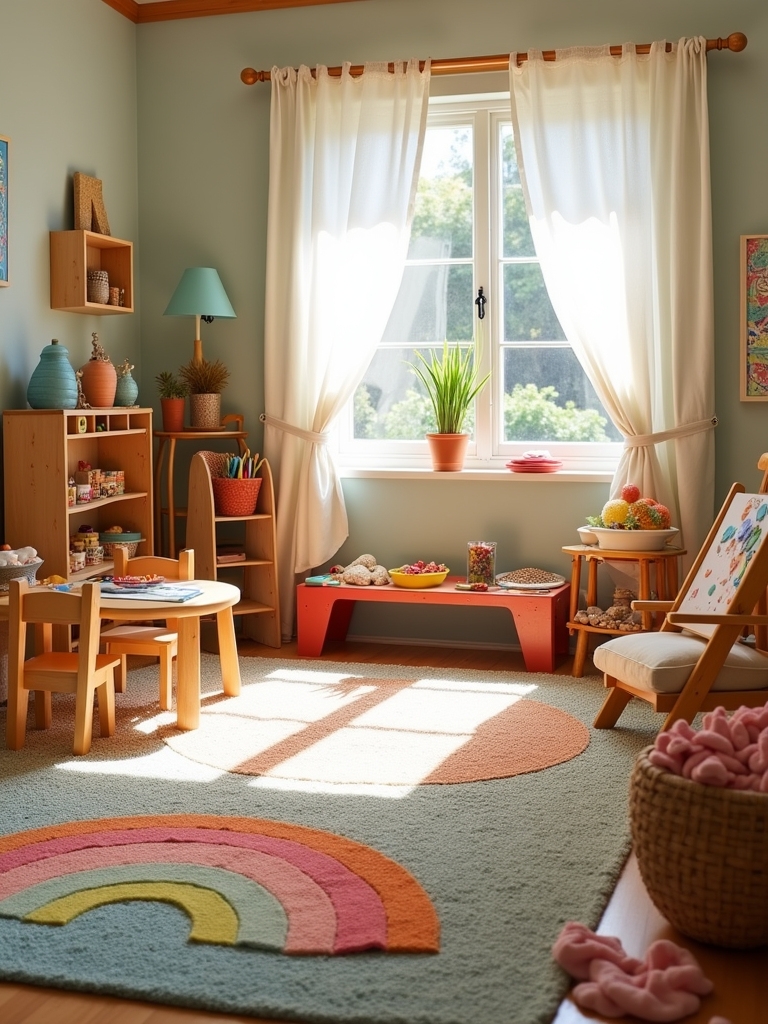
When I think about creating a Montessori playroom, one of the first things that comes to mind is setting up open-ended play stations. These areas encourage imaginative play and allow kids to explore their creativity. I love incorporating open-ended games, like building blocks or art supplies, as they foster problem-solving skills and collaboration. It’s amazing to see how children engage with these versatile activities.
Natural Materials and Textures
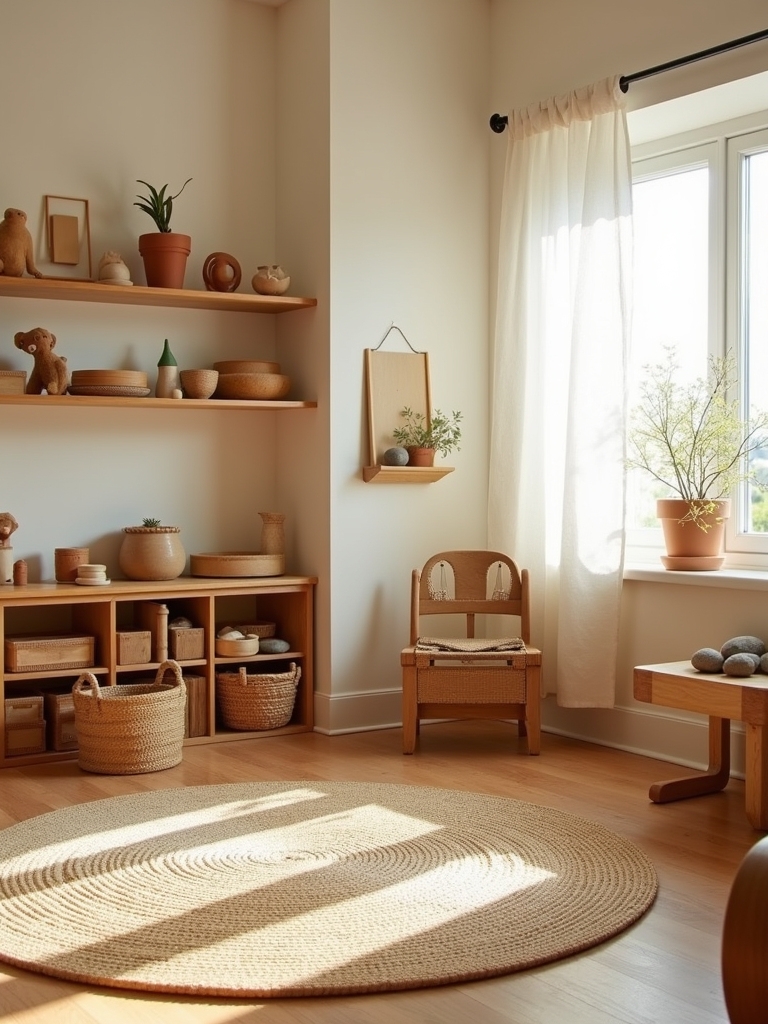
Incorporating natural materials and textures into a Montessori playroom adds an enriching layer to children’s learning experiences. By using sensory materials like wood, stone, and fabrics, we invite kids to explore diverse natural textures. These elements not only stimulate their senses but also foster creativity and imaginative play. Emphasizing organic shapes and colors encourages a deeper connection with the environment as they learn.
Low Shelving for Easy Access
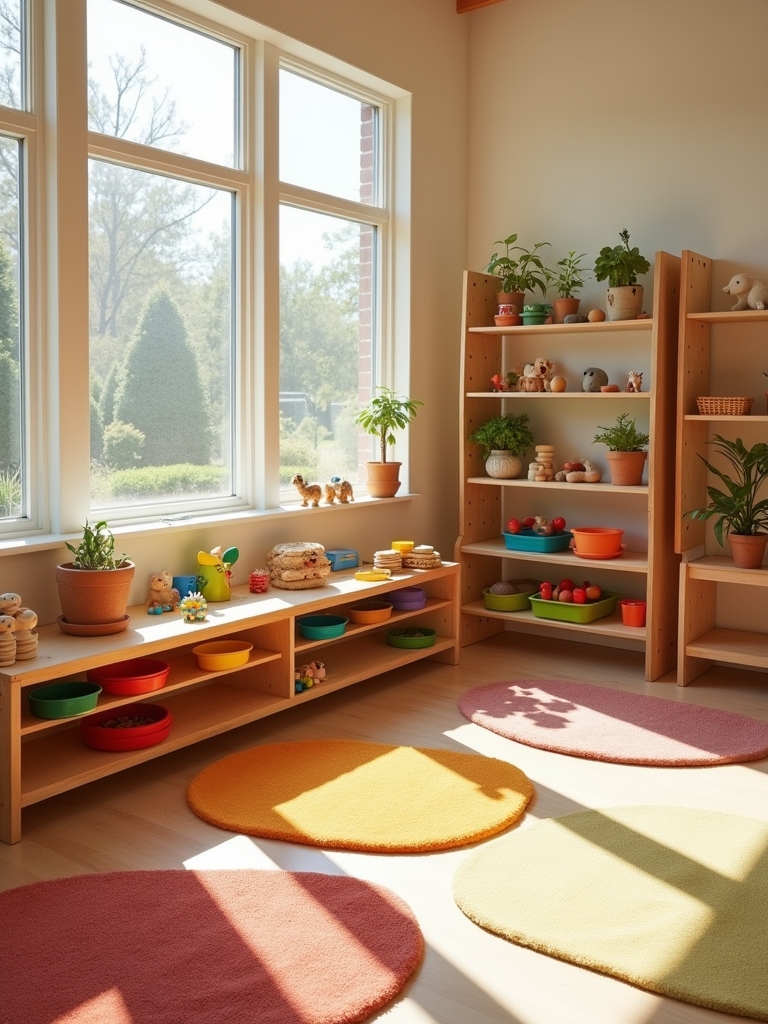
To create an inviting and functional Montessori playroom, low shelving is essential for easy access to toys and materials. This design fosters child-friendly accessibility, encouraging independent exploration. Here’s a simple table to illustrate some shelving ideas:
| Shelf Height | Purpose | Material |
|---|---|---|
| 12 inches | Books and puzzles | Wood |
| 24 inches | Art supplies | Metal |
| 30 inches | Blocks and manipulatives | Plastic |
Sensory Play Areas
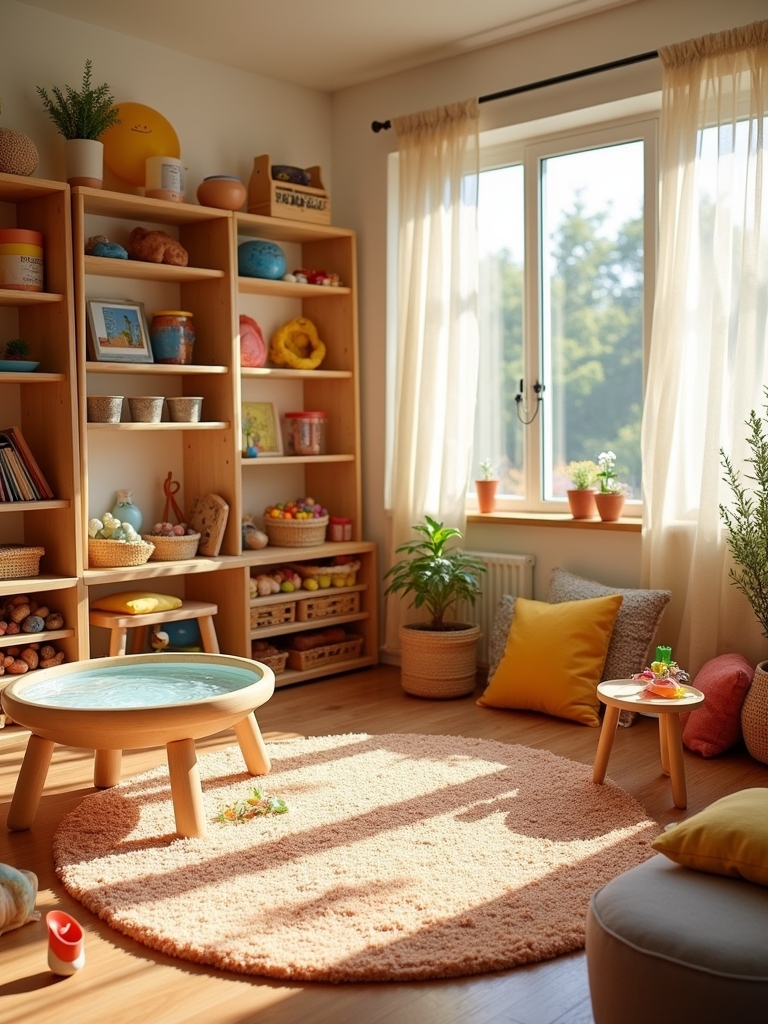
Creating sensory play areas in a Montessori playroom can greatly enhance a child’s learning experience. I suggest using sensory bins filled with various materials like rice, beans, or sand to provide tactile experiences. These bins encourage exploration and discovery, allowing children to engage their senses while developing fine motor skills. By incorporating different textures, kids can learn through hands-on interaction and creativity.
Art and Creativity Corner
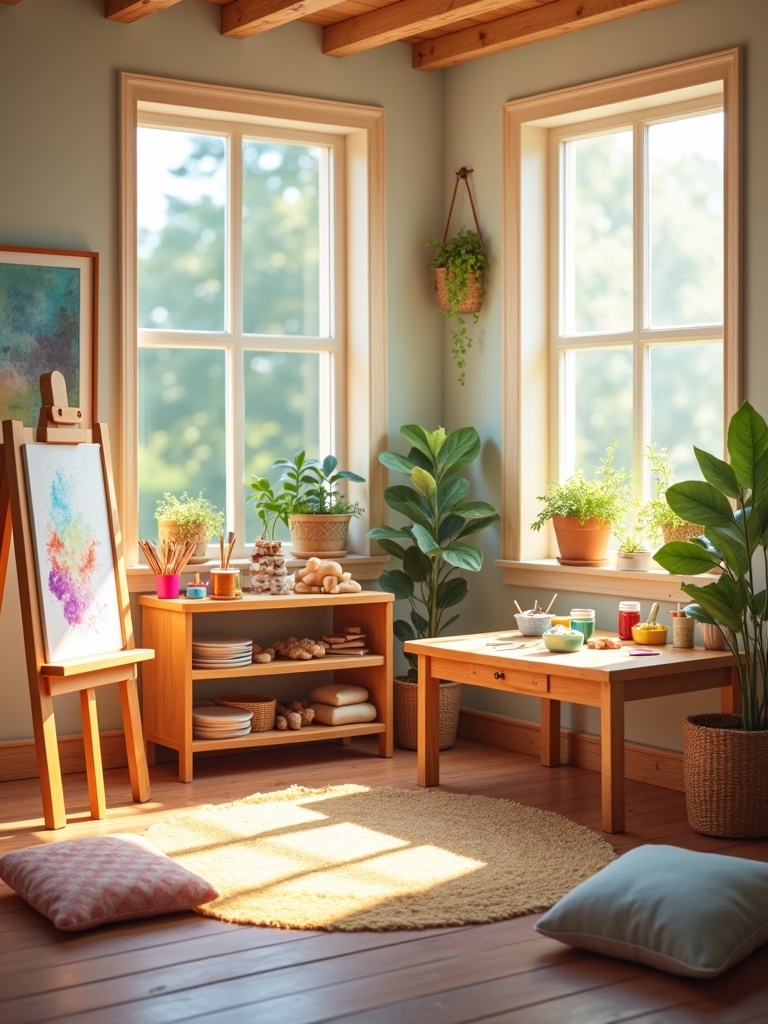
An Art and Creativity Corner in a Montessori playroom offers children a space to express themselves and explore their artistic abilities. I recommend setting up creative project zones, where kids can easily access various materials. Prioritize art supply organization to keep everything tidy and accessible. This encourages independence and fosters creativity, allowing little learners to immerse themselves in imaginative projects without unnecessary distractions.
Nature-Inspired Elements
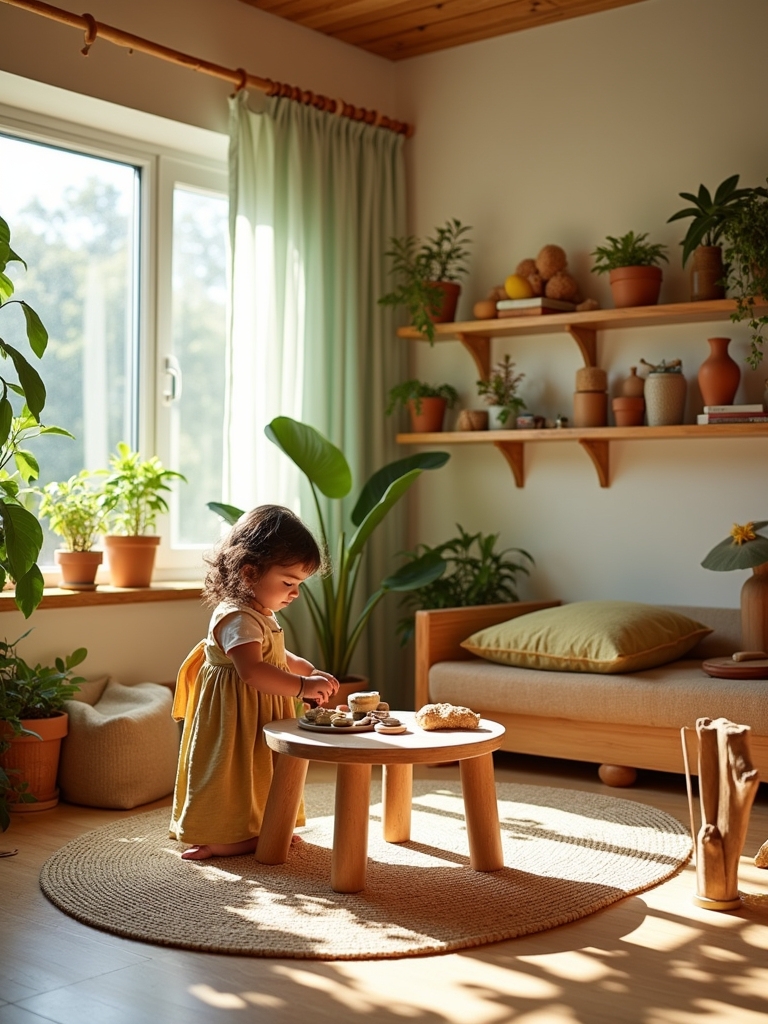
Incorporating nature-inspired elements into a Montessori playroom can considerably enhance a child’s learning experience. Consider adding:
Incorporating nature-inspired elements in a Montessori playroom significantly enriches a child’s educational journey.
- Nature themed decor, like wooden toys and botanical prints.
- A small indoor garden for plant exploration.
- Natural light through large windows.
- Textures from natural materials, such as cotton and wool.
These elements not only beautify the space but also foster curiosity and a love for the environment.
Practical Life Activities
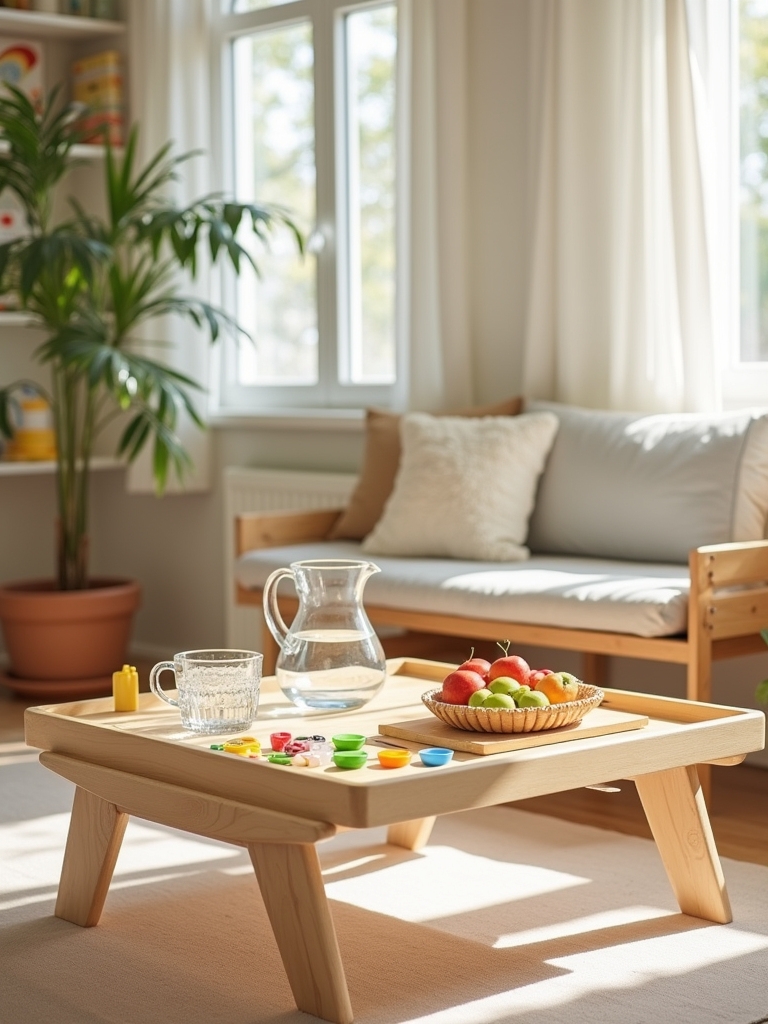
Nature-inspired elements lay a great foundation for engaging children’s senses, and from there, practical life activities can further enrich their learning environment. Activities like water pouring and using dressing frames teach essential skills while promoting independence. Here’s a quick look at how these activities can be categorized:
| Activity | Purpose |
|---|---|
| Water Pouring | Develops fine motor skills |
| Dressing Frames | Enhances self-care abilities |
| Combining Both | Boosts confidence and autonomy |
Cozy Reading Nook
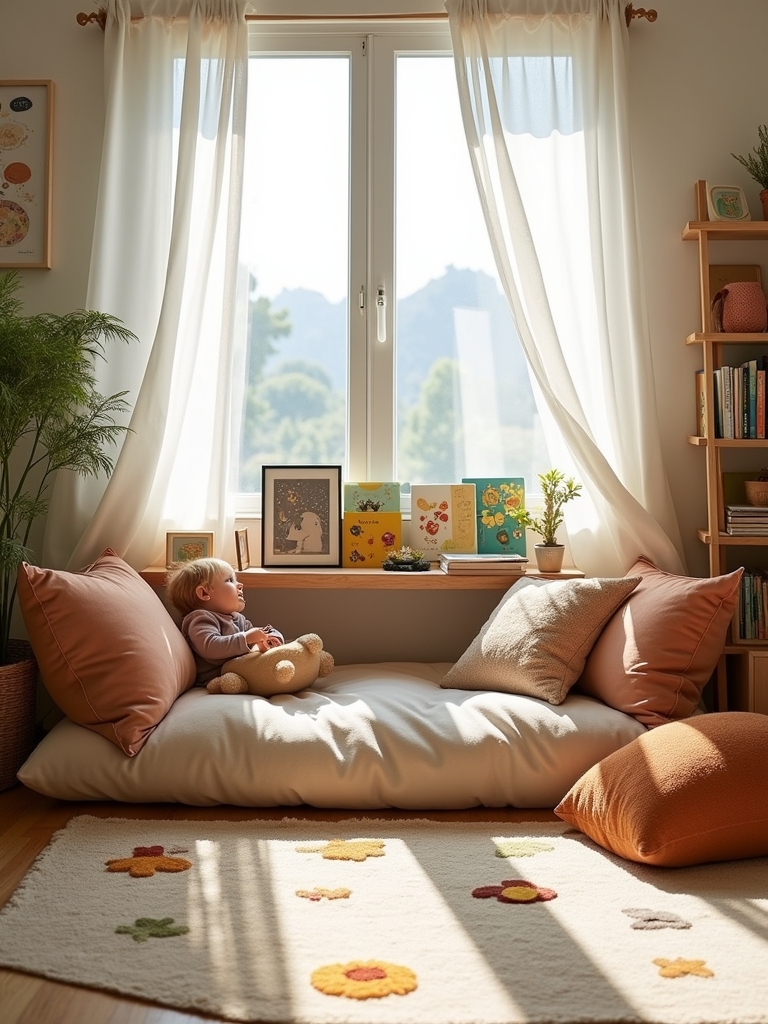
Creating a cozy reading nook can transform a corner of your home into a magical space where children can immerse themselves in books and explore new worlds. To enhance reading comfort, consider these elements:
- Soft cushions for relaxation.
- Warm lighting to create ambiance.
- Accessible book selection for varied interests.
- A small shelf for organization.
These features inspire a love for reading!
Montessori-Inspired Furniture
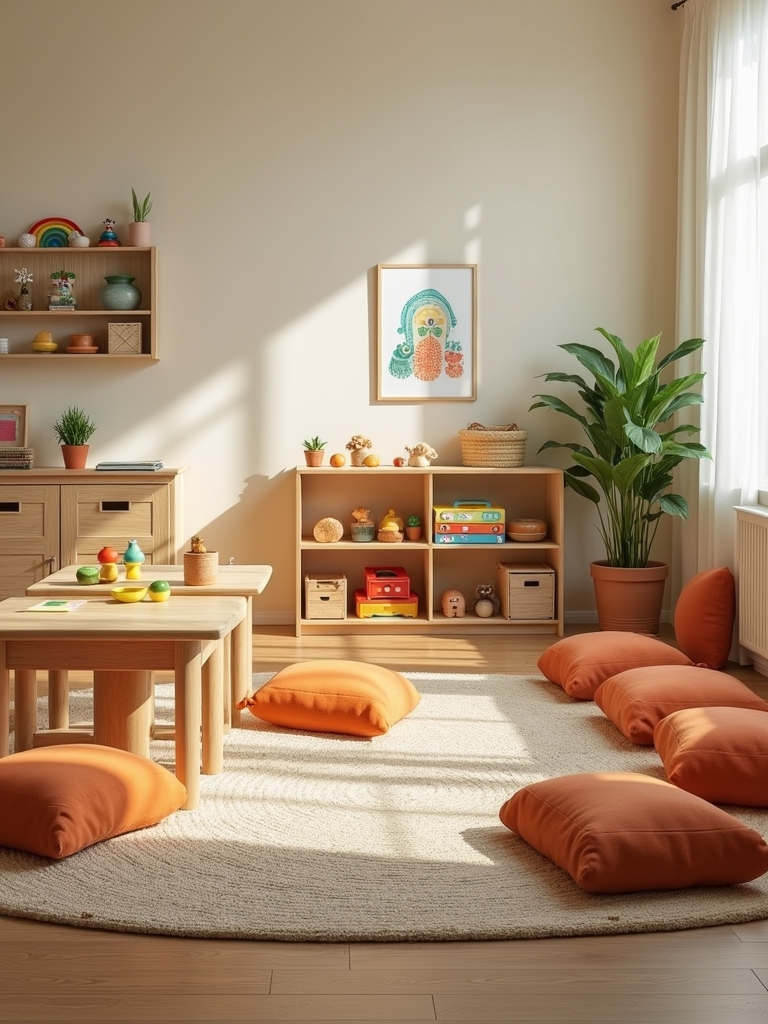
When you choose Montessori-inspired furniture, you’re not just opting for stylish pieces; you’re also promoting independence and learning in your child’s playroom. Emphasizing Montessori furniture styles, these pieces feature functional design that encourages exploration and creativity. Low tables, child-sized chairs, and open shelving empower children to access materials freely, fostering a sense of autonomy and responsibility in their learning environment.
Colorful and Engaging Wall Art
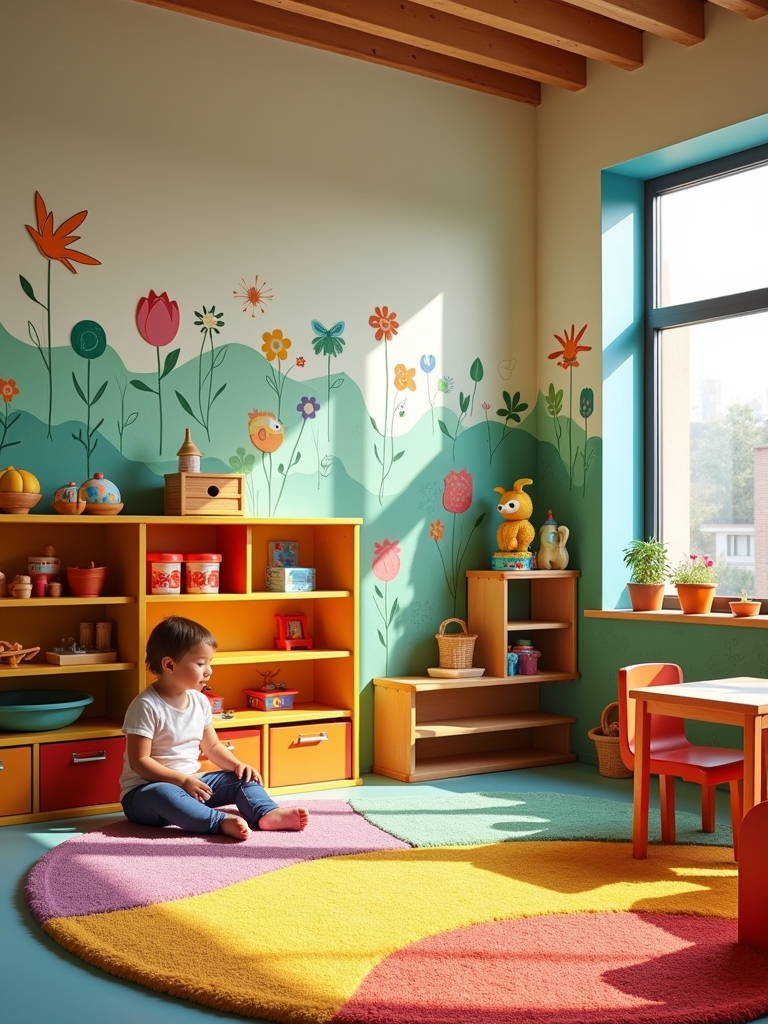
Wall art can transform a playroom into a vibrant space that sparks creativity and curiosity. Consider these ideas for engaging wall art:
- Whimsical murals that tell stories.
- Educational posters featuring letters or numbers.
- Nature-themed artwork to inspire exploration.
- Interactive wall decals that encourage play.
Incorporating these elements not only beautifies the space but also fosters a love for learning in little ones.
Movement and Exploration Zones
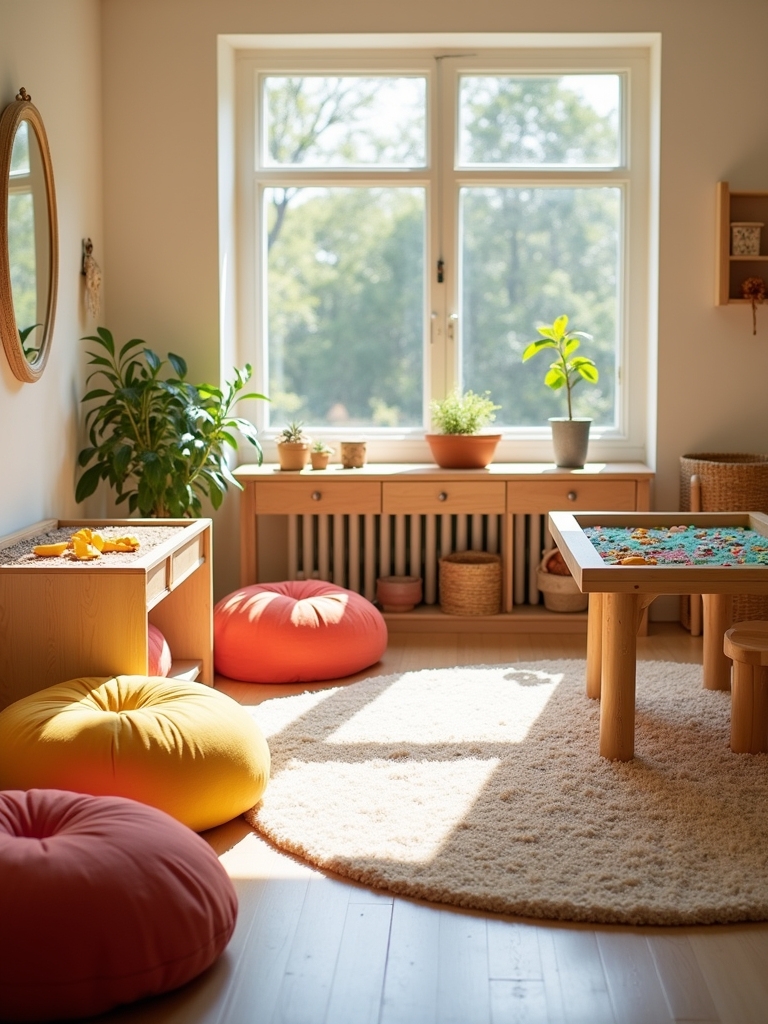
Movement and exploration zones are essential in a Montessori playroom, as they encourage children to engage their bodies and minds in active learning. Incorporating movement activities like climbing, jumping, and balancing helps develop physical skills. Pair these with exploration tools like magnifying glasses and sensory bins, allowing kids to investigate their environment. This combination fosters curiosity and promotes healthy, active lifestyles.
Interactive Learning Tools
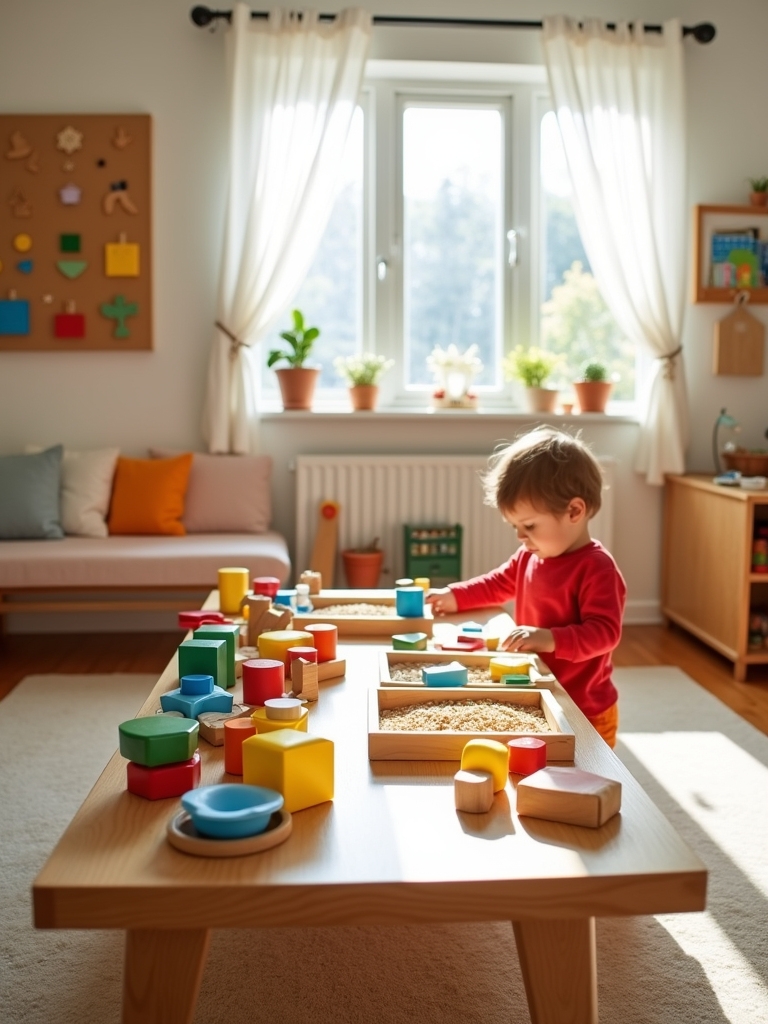
Interactive learning tools play an essential role in a Montessori playroom, enhancing children’s engagement and understanding of various concepts. Here are some innovative options to contemplate:
- Interactive storybooks that encourage participation
- Hands-on manipulatives for tangible learning experiences
- Digital resources that blend technology and education
- Activity kits that foster creativity and problem-solving
These tools stimulate curiosity and cater to diverse learning styles.
Role-Playing Areas
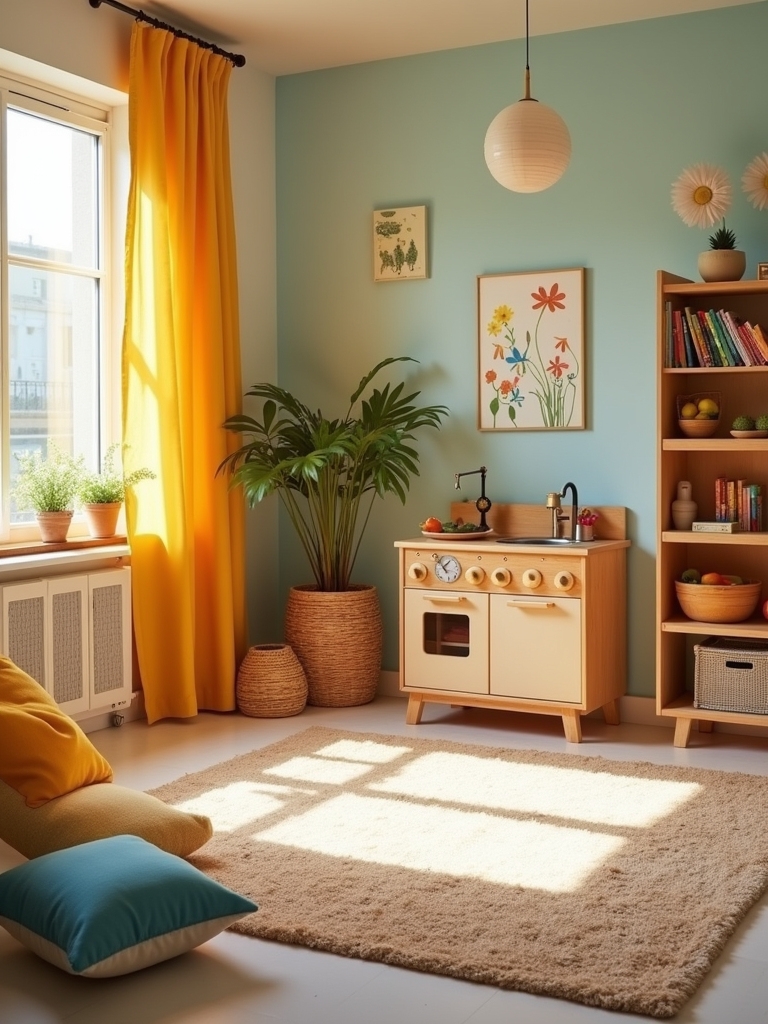
Role-playing areas are crucial components of a Montessori playroom, providing children with opportunities to explore their imagination and develop social skills. These spaces allow kids to engage in imaginative scenarios, acting out community roles like doctors, chefs, or teachers. By participating in these activities, children enhance their communication abilities and learn about cooperation, empathy, and responsibility, all essential for their growth and development.
Organization and Storage Solutions
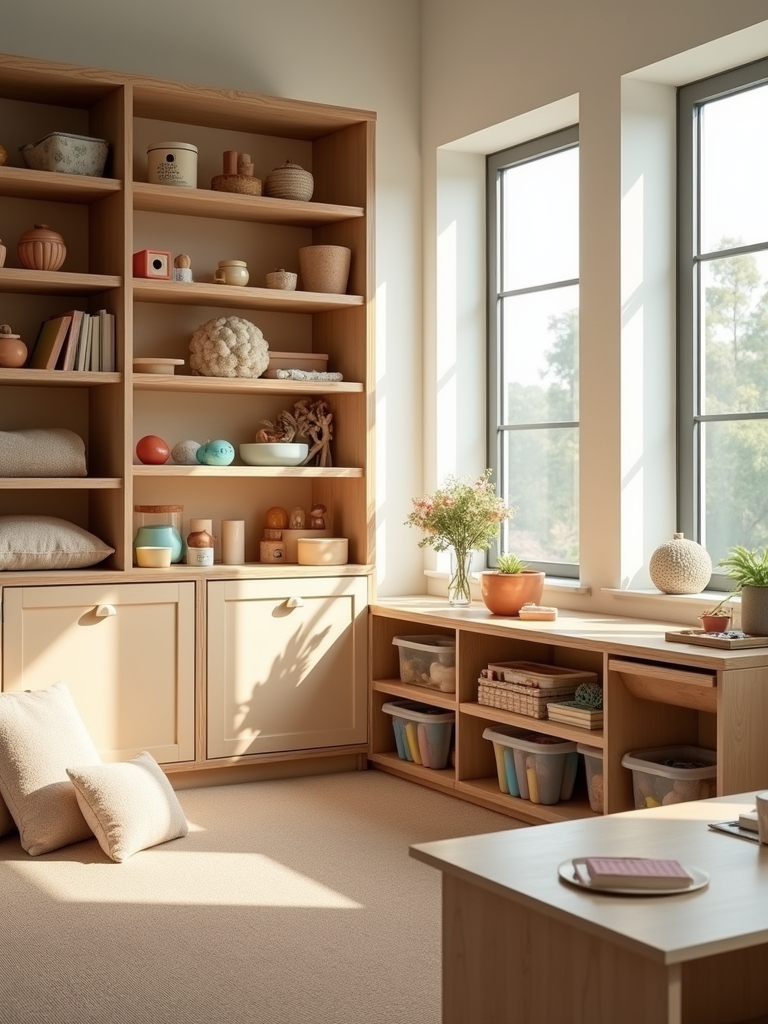
A well-organized Montessori playroom is essential for fostering independence and encouraging children to engage with their environment. Here are some effective organization and storage solutions:
- Use clear storage bins for visibility.
- Incorporate labeling systems for easy identification.
- Designate specific areas for different activities.
- Rotate materials regularly to maintain interest.
These strategies not only streamline play but also promote self-sufficiency in your little learners.
Outdoor Play Integration
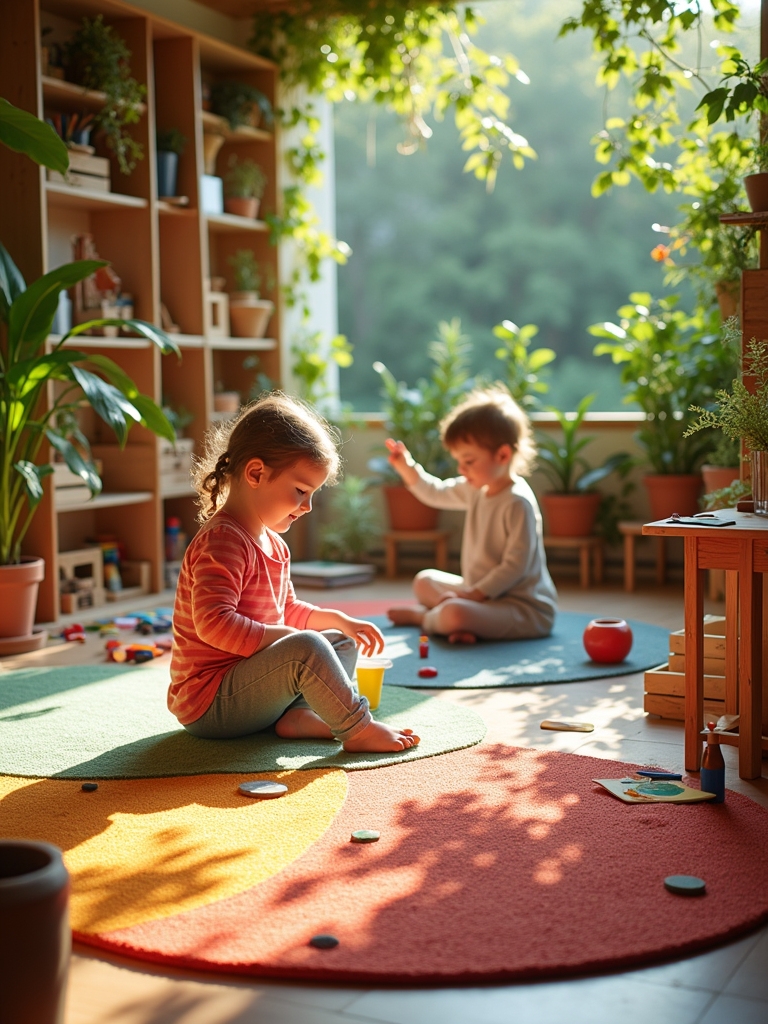
Integrating outdoor play into a Montessori environment is essential, since it helps children connect with nature while developing their physical and social skills. I love organizing nature scavenger hunts to encourage exploration and curiosity. Outdoor storytelling sessions also provide an engaging way for kids to learn about their surroundings. This blend of activities fosters creativity, teamwork, and a deeper appreciation for the environment.
Frequently Asked Questions
How Do I Choose the Right Size for a Montessori Playroom?
When choosing playroom dimensions, I focus on creating distinct learning zones. I measure the available space, ensuring each area encourages exploration and creativity, while also considering my child’s size and movement needs. It’s all about balance!
What Age Range Is Best for a Montessori Playroom?
When I think about a Montessori playroom, I picture a vibrant garden of learning. For toddlers, ages 1-3, it’s the perfect time for sensory exploration. Engaging activities bloom, nurturing their curiosity and growth.
How Can I Incorporate Montessori Principles at Home?
To incorporate Montessori principles at home, I focus on child independence by providing engaging Montessori materials. I create accessible spaces where my child can explore freely, fostering curiosity and confidence in their learning journey.
What Budget Should I Expect for a Montessori Playroom Setup?
When setting up a Montessori playroom, I expect a cost breakdown of around $300 to $500 for essential materials like furniture, educational toys, and sensory items. Prioritizing quality over quantity truly makes a difference!
Are There Any Safety Considerations for Montessori Playroom Design?
When designing the playroom, I prioritize safety by choosing non-toxic furniture materials and implementing childproofing measures. It’s essential to create a nurturing space that fosters exploration while ensuring my child’s safety and well-being.
Conclusion
Creating a Montessori playroom is like setting a stage for a performance where children are the stars. Each open-ended play station and sensory area provides them with the tools to explore, learn, and grow. Just as a well-organized toolbox helps a craftsman build effectively, your thoughtful arrangement of materials empowers little learners to build their knowledge and skills. By integrating these ideas, you’ll foster an environment that inspires curiosity and creativity, supporting their journey of lifelong learning.






